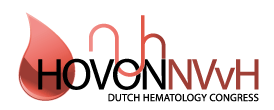Population-based external validation of the CAR-HEMATOTOX score to predict CAR T-cell related toxicity and outcome in R/R LBCL patients
Early identification of patients with an increased risk for immune effector cell-associated hematotoxicity (ICAHT) is crucial for early intervention and thereby minimizing non-relapse mortality due to toxicities and infections. The CAR-HEMATOTOX (HT) score has been proposed as a risk-stratification tool for ICAHT, infections and outcome in patients with relapsed or refractory large B-cell lymphoma (R/R LBCL) treated with CAR T cell therapy (CART). As no fully external multicenter validation has been performed, a comprehensive independent validation study is warranted.
Adults with R/R LBCL after ≥2 lines of systemic therapy who received CART as standard of care between May 2020 and December 2023 across all 7 Dutch CART centers were included. HT score was calculated per the original report, including absolute neutrophil count (ANC), hemoglobin (Hb), platelet count, C-reactive protein (CRP) and ferritin, determined prior to lymphodepleting chemotherapy. A high HT score was defined as HT score ≥2 (HThigh/HTlow). Patients with at least 3 out of 5 laboratory parameters were included. Missing laboratory values were imputed with predictive mean matching and pooled results are reported.
Of the 244 identified patients, 239 patients had ≥3 laboratory parameters available, with 141 complete cases. Median HT score was 2 (IQR 1-3], with 163 patients (68%) classified as HThigh.
Severe neutropenia (ANC <500/µl) after CART was common (n = 202/239, 85%), but only 50 patients (21%) experienced a duration of ≥14 days. A higher HT score was associated with a higher risk of clinically significant neutropenia (continuous HT: OR 1.61; 95% CI [1.24 – 2.08]; p < 0.01), and had a fair predictive performance (AUC 0.70). Any grade infection was seen in 73/193 patients (38%), with severe infections in 38 patients (20%). Incidence was comparable to previous reports. Both the continuous and the binary HT score were not associated with severe infections in our cohort (p = 0.10 and p = 0.46, respectively). CRS and ICANS grade ≥2 were apparent in 118/239 patients (49%) and 96/239 patients (40%), respectively. HT score was not associated with developing CRS or ICANS grade ≥2 (p = 0.38 and p = 0.16, respectively). Nevertheless, HT score was significantly associated with OS and PFS (HR 1.55; 95% CI [1.32 – 1.81]; p < 0.01 and HR 1.33; 95% CI [1.16 – 1.51]; p < 0.01, respectively).
In conclusion, higher HT scores identify patients at risk for severe neutropenia and reduced survival, but not for severe infections after CART in this population-based, real-world cohort. This study underscores the potential of the HT score, yet emphasizes the need for further optimalization before broad implementation and guidance of antibiotic prophylaxis strategies.

